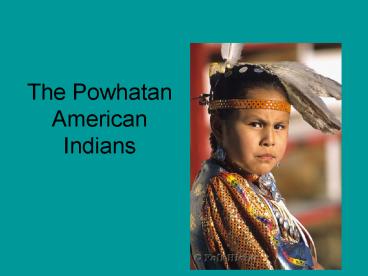The Powhatan American Indians - PowerPoint PPT Presentation
1 / 18
Title:
The Powhatan American Indians
Description:
A. The following items will be required at camp- sleeping bag, tent, hiking shoes, and compass. ... at camp, sleeping bag, tent, hiking shoes, and compass. ... – PowerPoint PPT presentation
Number of Views:656
Avg rating:3.0/5.0
Title: The Powhatan American Indians
1
The Powhatan American Indians
2
Please fill in the following boxes throughout
this presentation with the correct pictures and
word descriptions in each box. We will check your
answers at the end.
3
The Powhatan lived in the Eastern Woodlands.
4
The Powhatans land consisted of mountains and
forests and lots of different plant life, just
like where you live.
5
In fact, the Powhatan lived in Virginia, which is
where you live! I wonder if the Powhatan children
played in the same places that you play outside?
6
Since we know that the Powhatan lived where you
live, you already know what their climate (or
weather) was like
It was just like your weather now hot, humid
summers and mild (not too bad) winters.
7
The Powhatan lived in longhouses made with a wood
frame covered with bark and reed.
8
The Powhatan hunted, fished, and farmed for their
food.
9
The Native Americans gave us carving, pottery,
weaving, respect for nature, and knowledge of the
environment.
Indian weaving
Birch bark baskets
Canoe carving and art
10
The Powhatan traveled by walking and riding in
canoes.
- They could not go buy a canoe though, they
had to make it. The next slides will show you
how they made the canoe. The man demonstrating
how to build the canoe is from todays time. He
is re-enacting how the Native Americans made
canoes.
11
First
Bending Birch Bark Around a Frame They arrange
the pieces of birch bark on a building bed. A
weighted frame is placed on top of the bark.
Using hot water to make the bark more flexible,
they begin bending the bark into shape. The birch
bark is held in place with a series of stakes and
stays tied together with basswood bark.
12
Second
Staking the Birch Bark Canoe He inserts stakes in
holes in the building frame. Once the stakes are
firmly in place he holds the bark in place by
tying stays to the stakes with basswood bark.
13
Third,
Making the Prowpieces He splits out cedar trees
to make many parts of a birch bark canoe. Here,
he is bending a stempiece into place and tying
it. The stempiece and manboard are tied together
make up a prowpiece. A prowpiece is inserted into
each end of the canoe. Most of the prowpiece will
be hidden from view when the canoe is finished.
14
Fourth,
Sewing Birch Bark He gathers spruce root and
splits it for sewing or stitching the birch bark
canoe. Many different stitches are used, and he
shows all of these as the canoe is built. In this
image you can see the top of the manboard and the
gunwales.
15
Fifth,
Carving Installing Cedar Ribs Starting with a
cedar log, he demonstrates how to split out the
rib stock, carve it to shape, and fit it
together. The result is a light but durable birch
bark canoe capable of carrying people and their
gear as they explore America's wilderness.
16
Lastly,
Sealing the Seams Native Americans used the trees
and plants around them to make the things they
needed.They used pitch from trees to seal the
seams on the canoe so it would not leak.
17
Now lets check your answers
18
(No Transcript)





![READ [PDF] Pocahontas and the Powhatan Dilemma: The American PowerPoint PPT Presentation](https://s3.amazonaws.com/images.powershow.com/10117885.th0.jpg?_=20240902056)

























